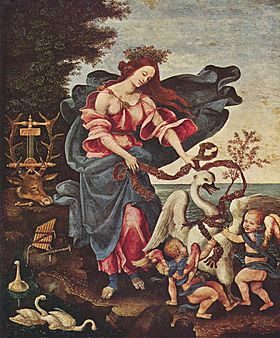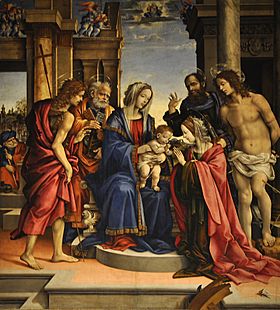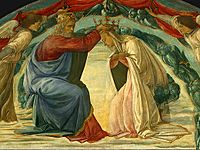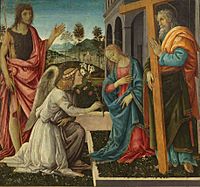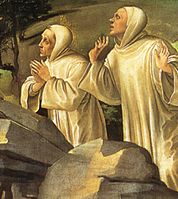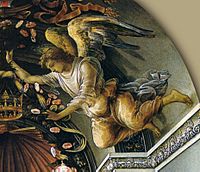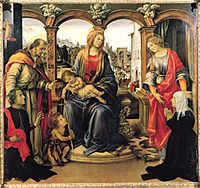Filippino Lippi facts for kids
Quick facts for kids
Filippino Lippi
|
|
|---|---|
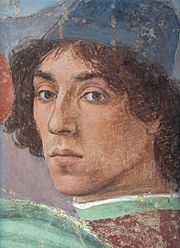
Self-portrait – detail from the Brancacci Chapel fresco The Dispute with Simon Magus (1481–1482), Santa Maria del Carmine, Florence, Italy
|
|
| Born |
Filippo Lippi
c. 15 April 1457 Prato, Republic of Florence
|
| Died | 18 April 1504 (aged 47) Florence, Republic of Florence
|
| Nationality | Italian |
| Education | Filippo Lippi |
| Known for | Painting, fresco |
|
Notable work
|
Apparition of the Virgin to St. Bernard Adoration of the Magi |
| Movement | Italian Renaissance |
Filippino Lippi (April 1457 – 18 April 1504) was an Italian painter working in Florence, Italy during the later years of the Early Renaissance and first few years of the High Renaissance.
Contents
Biography
Filippino Lippi was born in 1457 at Prato, Tuscany, the illegitimate son to Lucrezia Buti and the painter Fra Filippo Lippi. His sister, Alessandra, was born in 1465. Filippino first trained under his father in his workshop.
They moved to Spoleto, where Filippino served as workshop adjuvant during the construction of the Cathedral. When his father died in 1469, Filippino was aged twelve and he was among the assistants to his father who completed the frescoes with Storie della Vergine ("Histories of the Virgin") in the cathedral.
He then completed his apprenticeship in the workshop of Botticelli, who also had been a pupil of Filippino's father. In the 1472 records of the painters guild it is noted that that Botticelli had only Filippino Lippi as an assistant. The two collaborated routinely, such as the panels from a dismantled pair of cassoni, now divided among the Louvre, the National Gallery of Canada, the Musée Condé in Chantilly, and the Galleria Pallavicini in Rome. The works by Botticelli and Filippino from these years include many Madonna and Child paintings that often, are difficult to distinguish from one another.
His first solo works greatly resemble those of Botticelli, but perhaps with less sensitivity and subtlety. The very first ones (dating from 1475 onward) were initially attributed to an anonymous "Amico di Sandro" ("Friend of Botticelli"). Eventually Lippi's style evolved into a more personal and effective one over the years 1480–1485. Works of the early period include: the Madonnas of Berlin, London, and Washington, D.C., the Journeys of Tobia of the Galleria Sabauda, Turin, the Madonna of the Sea of Galleria dell'Accademia, Florence, and the Histories of Ester.
Together with Perugino (another pupil of his father), Ghirlandaio, and Botticelli, Lippi worked on the decoration of Lorenzo de' Medici's villa at Spedaletto. On 31 December, 1482, he was commissioned to decorate a wall of the Sala dell'Udienza of Palazzo Vecchio in Florence, a work never begun.
Soon after, probably in 1483–84, he was called to complete Masaccio's decoration of the Brancacci Chapel in the Santa Maria del Carmine di Firenze, that had been left unfinished at the artist's untimely death in 1428. There Filippino painted Stories of Saint Peter, in the following frescoes: Quarrel with Simon Magus in face of Nero, Resurrection of the Son of Teophilus, Saint Peter Jailed, Liberation, and Crucifixion of Saint Peter. His self-portrait at age twenty-five is at the right hand portion of the central panel, Disputation with Simon Magus and Crucifixion of St. Peter (see detail at info box).
Lippi's work on the Sala degli Otto di Pratica, in the Palazzo Vecchio, was completed on 20 February, 1486. It is now in the Uffizi Gallery. At about this time, Piero di Francesco del Pugliese asked him to paint the altarpiece with the Apparition of the Virgin to St. Bernard, which is now in the Badia Fiorentina, Florence. This is Lippi's most popular painting: a composition of unreal items, with its very particular elongated figures, backed by a phantasmagorical scenario of rocks and almost anthropomorphic trunks. The work is dated to 1485–1487.
Later, he worked for Tanai de' Nerli in Florence's Santo Spirito church.
On 21 April, 1487, Filippo Strozzi asked him to decorate the Strozzi family chapel in Santa Maria Novella with Stories of St. John Evangelist and St. Philip. He worked on this commission intermittently, over a long time. He only completed it in 1503, after Strozzi's death. The windows with musical themes, in the same chapel, also designed by Filippino, were completed between June and July 1503. These paintings can be seen as a mirror of the political and religious crisis in Florence at the time: the theme of the fresco, the clash between Christianity and Paganism, was hotly debated in the Florence of Girolamo Savonarola.
Filippino depicted his characters in a landscape that recreated the ancient world in its finest details, showing the influence of the Grottesco style he had seen during his time in Rome. In this way, he created an "animated", mysterious, fantastic, but disquieting style, showing the unreality of nightmare. Thus, Filippino portrayed ruthless executioners with the grimmest of faces, who raged against the Saints. In the scene of St. Philip expelling a monster from the temple, the statue of the pagan deity is represented as a living figure who seems to dare the Christian saint.
In 1488, Lippi went to Rome, where Lorenzo de' Medici had advised Cardinal Oliviero Carafa to entrust him with the decoration of the family chapel in Santa Maria sopra Minerva. These frescoes show a new kind of inspiration, quite different from his earlier works, but confirm Lippi's continued research on the themes of the Ancient era. He finished the series by 1493.
Lippi's return to Florence took place—the date is disputed—at some time between 1491 and 1494. Works of this period include: Apparition of Christ to the Virgin (c. 1493, now in Munich), Adoration of the Magi (1496, for the church of San Donato in Scopeto, now in the Uffizi), Sacrifice of Laocoön (end of the century, for the villa of Lorenzo de' Medici at Poggio a Caiano), St. John Baptist and Maddalena (Valori Chapel in San Procolo, Florence, inspired to some way extent by Luca Signorelli's art).
He also worked outside the area of his home city, on the Certosa, or Chapterhouse, in Pavia and in Prato, where, in 1503, he completed the Tabernacle of the Christmas Song, now in the City Museum; in 1501 Lippi painted the Mystic Wedding of St. Catherine for the Basilica of San Domenico in Bologna.
Lippi's final work was the Deposition for the Santissima Annunziata church in Florence, which at his death in 1504 was unfinished.
He died on April 18, 1504, at age forty-seven. Because of Lippi's fame and reputation, on the day of his burial all the workshops of the city closed to honor him.
Major works
- Madonna with Child, St. Anthony of Padua and a Friar (before 1480)—Tempera on panel, 57 × 41.5 cm, Museum of Fine Arts, Budapest
- The Coronation of the Virgin (c. 1480)—Tempera on panel, 90.2 × 223 cm, National Gallery of Art, Washington, D.C.
- Tobias and the Angel (c. 1480)—Tempera on panel, 33 × 23 cm, National Gallery of Art, Washington, D.C.
- Three Angels with Young Tobias (1485)—Oil on panel, 100 × 127 cm, Galleria Sabauda, Turin
- Portrait of an Old Man (1485)—Detached fresco, 47 × 38 cm, Uffizi, Florence
- Self-portrait—Detached fresco on flat tile, 50 × 31 cm, Uffizi, Florence
- Portrait of a Youth (c. 1485)—Panel, 51 × 35.5 cm, National Gallery of Art, Washington, D.C.
- Signoria Altarpiece (Pala degli Otto) (1486)—Tempera on panel, 355 × 255 cm, Uffizi, Florence
- Apparition of the Virgin to St. Bernard (1486)—Oil on panel, 210 × 195 cm, Church of Badia, Florence
- Annunciation with St. Thomas and Cardinal Carafa (1488–1493)—Fresco, Santa Maria sopra Minerva, Rome
- Madonna with Child and Saints (c. 1488)—Oil on panel, Santo Spirito, Florence
- St. Jerome (1490s)—Oil on panel, 136 × 71 cm, Uffizi, Florence
- Apparition of Christ to the Virgin (c. 1493)—Oil on panel, 156.1 × 146.7 cm, Alte Pinakothek, Munich
- Adoration of the Magi (1496)—Oil on panel, Uffizi, Florence
- Madonna and Child with Saints (1498)—Fresco, 239 × 141 × 71 cm, Museo Civico, Prato
- Allegory (c. 1498)—Oil on panel, 29 × 22 cm, Uffizi, Florence
- Allegory of Music (Erato) (c. 1500)—Tempera on panel, 61 × 51 cm, Staatliche Museen, Berlin
- Crucifixion, c. 1501— tempera on panel, 31.2 × 23.4 cm, Museo Civico, Prato
- Mystic Marriage of St. Catherine (c. 1501–1503)—Panel, Basilica di San Domenico, Bologna
- Madonna and Child, St. Stefan and St. John the Baptist (1502–1503)—Tempera on panel, 132 × 118 cm, Museo Civico, Prato
- Deposition (1504, finished by Perugino in 1507)—Oil on panel, 333 × 218 cm, Galleria dell'Accademia, Florence
School works
Following works are permitted to be cited as Filippino's school works.
- the Madonna, Child and St. John—tondo, Keglevich collection, Budapest,
- Cenacolo di S. Apollonia—Florence
- the Virgin giving her girdle to St. Thomas—Florence
- St. Anthony Abbot—Florence
Gallery
- Works and details
-
The Coronation of the Virgin (detail) (c. 1480)
Tempera on panel, 90.2 × 223 cm, National Gallery of Art, Washington, D.C.
See also
 In Spanish: Filippino Lippi para niños
In Spanish: Filippino Lippi para niños
- Brancacci Chapel
- Carafa Chapel
- Strozzi Chapel



